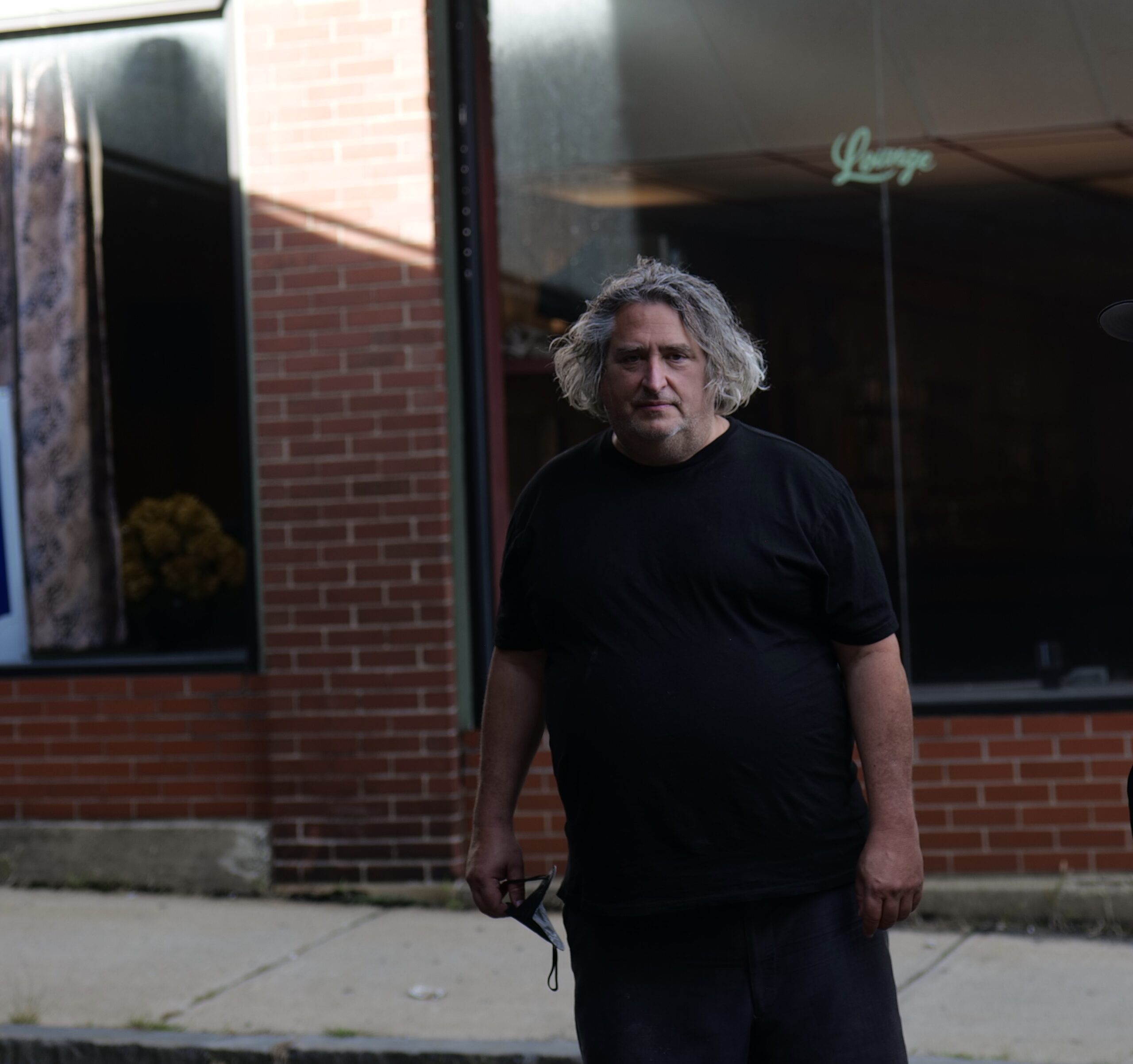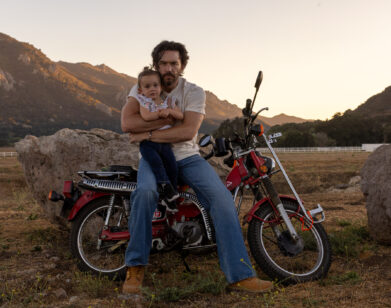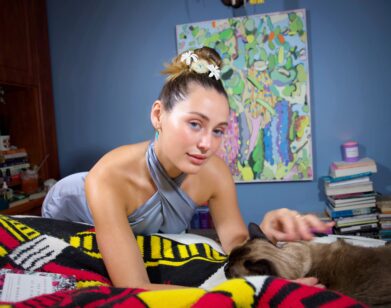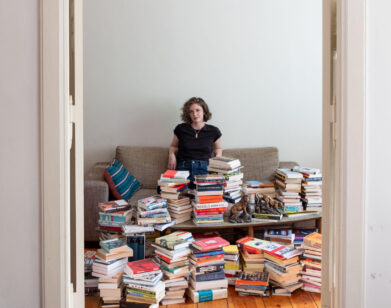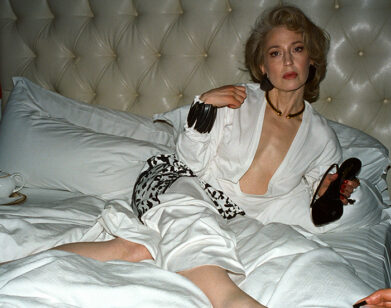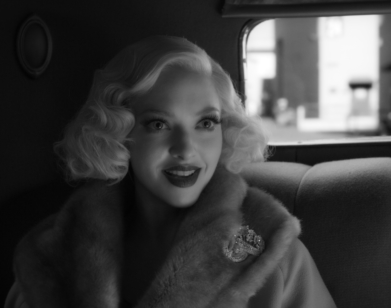NOIR
Photographer Gregory Crewdson on Blue Velvet and the Berkshires
When Gregory Crewdson’s newest body of work, Eveningside, premiered at the Gallerie d’Italia last fall, it was accompanied by a little-known selection of firefly photographs he took more than 25 years ago. At first blush, the two series have little in common: Eveningside, like much of Crewdson’s later work, is glossy and meticulous; Fireflies is grainy and instinctive. But a new monograph reveals that they have one important trait in common: both were shot in the Berkshires region of Western Massachusetts, where the artist spent summers growing up and now owns a home of his own.
For years, Crewdson has turned the Berkshires’s small, post-industrial towns into what look like big-budget film sets for days at a time. He is to the area what, say, Berenice Abbott, is to pre-war New York: a transplant whose vision of the place has indelibly shaped our collective mental image of it. In Crewdson’s world, a thick mist lingers everywhere. Old craftsman homes and storefronts are forever empty; so are the stares of the few characters that wander in the streets before them. Crewdson, for his part, doesn’t seem so desultory. He called me from his Berkshires home to talk about his new book, which for the first time brings together Eveningside and his recent projects Cathedral of the Pines and An Eclipse of Moths, completing a planned trilogy. What began as a moment of reflection for the now-60-year-old photographer as he looked back at the last decade of his work quickly digressed into a discussion of Davids: Lynch, Fincher, and Foster Wallace.
———
TAYLOR DAFOE: Thanks for making time to do this with me, Gregory.
GREGORY CREWDSON: It’s my pleasure.
DAFOE: The first question I have for you is about your decision to include Fireflies, a body of work from over 25 years ago, in your book. It was shot on 35 millimeter and with a panoramic medium format camera; perhaps most interestingly, there is not the same sense of control that I find a lot of your later images have. What was behind that decision?
CREWDSON: Well, that’s a good starting point. On the surface, there seems to be very little in common between these three bodies of work and the firefly pictures. Certainly, in terms of how they were made, they couldn’t be more different. But when we were organizing the show, we kept talking about the fireflies as a kind of connecting tissue or a counterpoint to the other bodies of work. They’re very much made on the same kind of location or landscape. Those pictures were made in the 1990s during the summer on my family’s property, which no longer exists in that same form. But at the fundamental level, those pictures are concerned with light and meaning. The light of a firefly is a mating call, and when I made those pictures that summer, I was just enthralled with the experience of light in twilight. At the end of the summer, I had all the film developed and processed and made contact prints, and when I saw the results, they didn’t map up to my original experience of it.
DAFOE: Sure. The firefly, a notoriously hard thing to photograph.
CREWDSON: Impossible. And that’s part of the draw. So I put them in a box and it wasn’t until 10 years later that I rediscovered them. By that time, I was halfway through Beneath the Roses and I was just enthralled by their simplicity. But the more I thought about it, I liked it as a kind of counterbalance. And it looks really beautiful in the show because they’re very small, they kind of have the intimacy of the firefly. So it’s really about location, mood, the uncanny, which runs through all my pictures, I guess.
DAFOE: Where was your family’s cabin?CREWDSON: Well, I grew up in Park Slope in Brooklyn. And my father was from the West Coast and he’s a psychotherapist. For some really unknowable reason, he was interested in coming up to the Berkshires—I think he was drawn to it just by not feeling very comfortable in New York, and also loving music and Tanglewood. Somehow, he founded this trust of land in the ’60s and brought 10 other families into this big project, in the idealistic ’60s sense of community and communes and stuff. Didn’t really pan out that way. So one of my very defining experiences is coming up to this cabin in Beckett, Massachusetts, me, my brother and my sister.
DAFOE: You’ve returned to the Berkshires time and time again in your work. And I think in these three most recent bodies of work, the land and the cities of this region are the subjects of the photos as much as the people that populate them. But as I was spending time with the book, the amount of control you seem to exert over your pictures made me wonder if there’s maybe not as much actual place in them after all, that maybe I’m confusing a kind of reverence for a particular place with your very skilled manufacturing of setting.
CREWDSON: It’s a really good point, and it’s both those things for me. Like all photographers who deal with landscape or place, they’re really dealing with two kind of competing forces. You’re responding to the place directly; and the other is, whether you’re thinking about it or not, you’re inventorying your experience with previous images of the place, whether it’s movies or other photographs or other narrative forms. So it’s impossible to have a direct, innocent experience of a place.
DAFOE: As detailed as your pictures are, they’re also quite open and ambiguous, to the point that it’s easy for people to project onto them certain ideas or narratives. I read multiple pieces of writing during the pandemic that located in your work a connection to the isolation of that moment.
CREWDSON: Firstly, I think it’s kind of part and parcel of the medium itself: photography. Unlike other narrative forms, no matter what you do, your story is going to be incomplete; it’s always going to be a question mark, it’s never going to fulfill itself, unlike a movie, I’d say. Even an abstract movie exists in time and has duration. So I’ve always seen that limitation as a strain in terms of my viewpoint, partially because I’m somewhat limited in terms of my capacities. I don’t think linearly. But the question for me, always, is how much of a story do you want to tell and how much do you not want to tell? In the end, I always feel it’s better to tell less than more.
DAFOE: I think your work has told less and less as it’s progressed.
CREWDSON: I agree. If you look back at my early work, Twilight and those pictures, I was younger and intoxicated with just the possibility of making these epic pictures with lots of light, in a sort of hyperbolic way. But I’m still very, very interested in telling stories through light, that’s at the core of it.
DAFOE: With Eveningside, I found myself thinking about mirrors a lot, which are quite prevalent in that particular series. There are shots of characters looking into mirrors, and also broader examples of mirroring in terms of composition and subject matter. What kind of roles do mirrors play in Eveningside?
CREWDSON: I think it’s definitely keyed up in those pictures. The very act of making a picture is this act of looking through a frame. I’m really interested in making pictures that reference the act of making pictures. So I always, in one way or another, put frames around figures, whether it’s through a doorway or a window or a car. Frames within frames are always interesting to me. But there’s also a psychological element to it. It feels enclosed, slightly claustrophobic; there’s a slight sense of unease about that. And as I was making these pictures, I started becoming more and more fascinated with these sort of marginal, almost non-existing stores and storefronts. We just sometimes embellished them slightly with signage. And the mirrors started to play in sort of an uncanny way, too.
DAFOE: At one particularly caffeinated part of my research for this interview, I was thinking that, in some ways, Eveningside is the most realistic body of work that you’ve made in a while. I’ve been reading a lot of David Lynch recently so…
CREWDSON: A big Lynch fan, of course. I actually saw Blue Velvet when I was in graduate school and it definitely was a life-changer in terms of showing us a world that feels familiar but really strange. And then, I got to know him a bit, such an interesting person and artist.
DAFOE: Were you able to crack his code?
CREWDSON: No, no, no, no. He’s opaque, but so generous at the same time.
DAFOE: I just read the David Foster Wallace essay on Lynch, and he too talks about experiencing Blue Velvet while in grad school.
CREWDSON: Really? In which book?
DAFOE: A Supposedly Fun Thing I’ll Never do Again.
CREWDSON: David Foster Wallace would’ve probably been my age now, so yeah, I definitely don’t think I was alone there. A lot of this comes down to my decision to make pictures in black and white, which is a big key to the whole thing. I love black and white, history is black and white photography, of course. I love the whole history of film noir. There’s also been a recent bout of movies that have used really high-end digital technique in black and white; Mank, which I thought was gorgeous.
DAFOE: I loved Mank. I’m a big Fincher fan.
CREWDSON: Me too. Huge Fincher fan. Here’s a really interesting thing: Erik Messerschmidt, who was the DP, started with us. When he was like 23, he worked on Dream House and then worked on some of the Beneath the Roses productions. And we have maintained a friendship ever since. So then, I was thinking it would be really great to bring high-end digital, but make it feel classical.
DAFOE: When did you make the switch from large format to digital?
CREWDSON: My last body of work in eight-by-ten was Beneath the Roses.
DAFOE: In a lot of writing about photography, I find that there’s a kind of fierce and often unhealthy obsession with process, so much so that at times the pictures become secondary. With your work, it’s particularly tempting to focus on process because it’s so unique. You’re also really open about the way you work and who you make the work with. Do you ever find that the kind of process-obsessed rhetoric of photography shapes or even limits the way we view your work?
CREWDSON: Yeah. My whole take on that is that photography is a technological medium. That’s just a given. The irony is I’m not particularly good at any part of it. I mean, I’m not technical, but I know how I want my pictures to look, I guess, so I use any tool that can help me get there. This is the only way I know how to make a picture. I learned how to do this through a long process and I would be completely stumped if I was asked to just make up a series of pictures with just a camera. Because it’s not what I do. It’s not how I think. So I do show a lot of behind-the-scenes stuff because, first of all, I love giving the people who I’ve worked with over all these years that kind of platform. But the picture itself is the thing, and there’s only one way it could look in my mind. To me, what’s most important is the form and the meaning of the picture. It’s the only thing I’m interested in.
DAFOE: It was reported six or seven years ago that a producer had optioned Carla Buckley’s novel The Deepest Secret and that you were attached to direct. I’m curious what happened with that project, and whether you’re still interested in making a film.
CREWDSON: The Deepest Secret was never made. That is a very long story, but we optioned this book and we started thinking about how we could change it to make it more like my pictures. By the time it was actually a thing, there was no resemblance to the actual story. It got very close to actually being made, but I pulled out because I didn’t feel like it had the right budget. Am I being vague enough? The idea is if it ever happened, it would have to be the right circumstances and the right situation. The challenge would be telling a story that felt very much in line with my photographs. I really do think in terms of still images, so the idea of making a movie is pretty scary.
DAFOE: When I was younger interviewing photographers, I would always ask about the influence of film on their work, and every one of them would always downplay it to the extent that they would say that it had virtually no influence at all. I interviewed Roger Deakins actually and he said the same thing. I was shocked by this.
CREWDSON: What did he say, exactly? That he wasn’t influenced by photographs?
DAFOE: Yeah. Basically, when he’s shooting still photographs versus making a film, he’s not flexing the same muscles at all.
CREWDSON: That’s really interesting. I would almost say I’m more influenced by movies than by photographs. I’m much more excited to look at and inspired by movies, so I’m the opposite. And everyone who works on our pictures works mostly in movies, independent movies and stuff, and I think they really love doing it.
DAFOE: I, for one, hope you do make a movie. I think it would elucidate a lot of things about your still pictures.
CREWDSON: When we’re making a picture, there’s so many things I don’t have to worry about. “What happens next?” I don’t have to worry about that.
DAFOE: I also wonder if you would go the other direction and strip back the way you work so much so that it’s just you and a camera, but it sounds like that’s not on the table either.
CREWDSON: I can’t do it. I admire that so much when I look at other photographers’ work. It’s not like I have an ethical position, it’s just I know what my lane is. When I look at Eggleston’s work or Winogrand’s, this idea of having this camera that’s sort of connected to your body, and you’re responding in an intuitive way, I just don’t know how to do it. Everyone has their way. Every photographer or artist has figured out their own particular relationship to the medium and these things don’t happen haphazardly.
DAFOE: Do you consider yourself a perfectionist?
CREWDSON: I feel that there’s an interesting contradiction in my work. I do have this impulse to try to create something perfect, but I also know that failure or disappointment is just part of the medium. You have an image in your head and then, when you make it, it becomes something other than that. The best part is when you see it happening, you make the picture and you’re there on set and you actually see the picture coming to life. I live for that, really, more than any other thing. The worst part of the process is when you’re done and looking at what you have and it never ever, ever feels like what you saw. So you feel like the process has failed you in some way. Or representation has.
DAFOE: I don’t have too many more questions for you, Greg. Is there anything else you want to touch on while we’re still on the horn together?
CREWDSON: I think that’s it. I really enjoyed the conversation. I feel like we accomplished something here.
DAFOE: Cool. I appreciate that.

